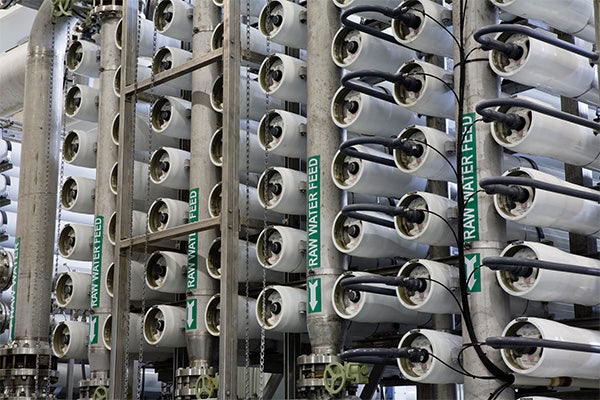Turning trash into treasure to help quench the world’s thirst sustainably
Young-Shin Jun to develop a novel value-adding treatment method for water purification byproducts

Reverse osmosis (RO) is used to purify water worldwide for both drinking and industrial use, and it will only become more important in the future as additional desalination plants are required to meet demand. Particularly in areas where freshwater scarcity is an issue, RO provides the principal method to desalinate water for human consumption and to recycle wastewater for use in agricultural or industrial applications. However, RO water processing requires pretreatment with antiscalants and produces a large quantity of concentrated waste, known as reverse osmosis concentrate (ROC), which must be treated before it can be disposed of safely.
“Desalination and reverse osmosis concentrate treatment are key to achieve water sustainability,” said Young-Shin Jun, professor of energy, environmental & chemical engineering in the McKelvey School of Engineering at Washington University in St. Louis. “Considering climate change and unprecedented water demand owing to socioeconomic development, resilient societies can only be possible with a secure, clean water supply.”
With a $1.35 million grant from the U.S. Department of Energy, Jun aims to turn this concentrated waste into valuable products for industrial use. Jun’s collaborators include researchers from Colorado State University, Clarkson University, Argonne National Laboratory and OLI Systems Inc.
RO water treatment systems rely on antiscalants to prevent the buildup of particles and minerals on RO membranes, thereby maintaining their performance and longevity. However, antiscalants make ROC difficult to solidify and extract in later processes. Jun and her team will examine exactly how antiscalants affect the formation and composition of ROC to treat it more efficiently to maximize water recovery and transform ROC from hazardous waste into useful material resources.
The team plans to design a new electrochemical approach to break down antiscalants in the highly concentrated salty water leftover after RO treatment. They will also develop a process for selectively nucleating sparingly soluble minerals and highly soluble salts, reducing energy costs and increasing waste conversion into more useful products. By developing treatments to make ROC not only safe but usable, Jun envisions a future water economy that is more circular and sustainable.
“If we can find a better way to treat ROC, then we have a big opportunity to make something useful, to actually make value from waste,” Jun said. “Instead of dumping it into the soil or sea, we want to make ROC into a valued product for industries that need salts, such as treating roads in winter weather, construction cements, and other applications that use salts in chemical feedstocks. Our new treatment process will enable a circular water economy system, where instead of wasting, we’re recovering and producing useful products from what we removed to decontaminate water.”




